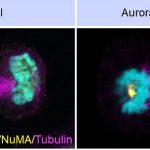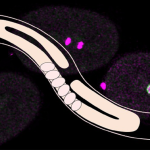
When eukaryotic cells divide, thread-like structures called spindle fibres help pull a copy of the replicated chromosomes into each daughter cell. The forces responsible for this pulling should be generated at the right time to ensure error-free cell division. In animal cells, a protein called NuMA plays an integral role in this process.
One of the ways that cells regulate such proteins is by adding or removing phosphate groups. When NuMA is dephosphorylated at an amino acid residue called T2055, it localises to the cell cortex where it helps anchor the motor protein, dynein, essential for generating spindle forces. However, enzymes like Cdk1 can block its localisation by phosphorylating NuMA.
Very little is known about the dynamics of these two processes. Researchers from the Department of Microbiology and Cell Biology have now identified and characterised the subunit (B55γ) of an enzyme called PP2A responsible for dephosphorylating NuMA at T2055. The researchers suggest that a tug-of-war between Cdk1 and PP2A-B55γ regulates cortical NuMA levels.
As low levels of B55γ are linked to prostate cancer, future research will attempt to unravel the role of spindle formation in cancer progression.






